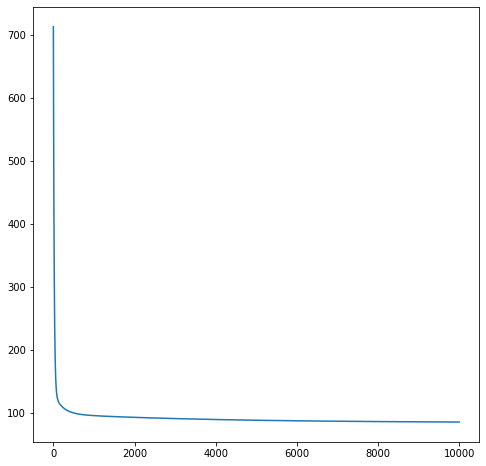tensorflow 入门之五- 多变量线性回归
import tensorflow as tf
import matplotlib.pyplot as plt
import numpy as np
tf.__version__
'1.14.0'
# 加载数据
boston=tf.contrib.learn.datasets.load_dataset('boston')
x_train,y_train=boston.data,boston.target
# 预览前五行
x_train[:5],y_train[:5]
(array([[6.3200e-03, 1.8000e+01, 2.3100e+00, 0.0000e+00, 5.3800e-01,
6.5750e+00, 6.5200e+01, 4.0900e+00, 1.0000e+00, 2.9600e+02,
1.5300e+01, 3.9690e+02, 4.9800e+00],
[2.7310e-02, 0.0000e+00, 7.0700e+00, 0.0000e+00, 4.6900e-01,
6.4210e+00, 7.8900e+01, 4.9671e+00, 2.0000e+00, 2.4200e+02,
1.7800e+01, 3.9690e+02, 9.1400e+00],
[2.7290e-02, 0.0000e+00, 7.0700e+00, 0.0000e+00, 4.6900e-01,
7.1850e+00, 6.1100e+01, 4.9671e+00, 2.0000e+00, 2.4200e+02,
1.7800e+01, 3.9283e+02, 4.0300e+00],
[3.2370e-02, 0.0000e+00, 2.1800e+00, 0.0000e+00, 4.5800e-01,
6.9980e+00, 4.5800e+01, 6.0622e+00, 3.0000e+00, 2.2200e+02,
1.8700e+01, 3.9463e+02, 2.9400e+00],
[6.9050e-02, 0.0000e+00, 2.1800e+00, 0.0000e+00, 4.5800e-01,
7.1470e+00, 5.4200e+01, 6.0622e+00, 3.0000e+00, 2.2200e+02,
1.8700e+01, 3.9690e+02, 5.3300e+00]]),
array([24. , 21.6, 34.7, 33.4, 36.2]))
x_train.shape,y_train.shape
((506, 13), (506,))
从上来看, 共有 506 条数据,13 个参数
# 给 x_train 加上首列全为 1 的数据
x_train=np.insert(x_train,0,values=1,axis=1)
x_train.shape
(506, 14)
线性回归模型:
y
=
w
0
+
w
1
∗
x
1
+
w
2
∗
x
2
+
w
3
∗
x
3
+
w
4
∗
x
4
+
.
.
.
+
w
n
∗
x
n
y=w_0+w_1*x1+w_2*x_2+w_3*x_3+w_4*x_4+...+w_n*x_n
y=w0+w1∗x1+w2∗x2+w3∗x3+w4∗x4+...+wn∗xn
也等于
y
=
W
T
∗
X
=
θ
T
∗
X
y=W^T*X=\theta^T*X
y=WT∗X=θT∗X
# 获取维度
m,n=x_train.shape[0],x_train.shape[1]
m,n
(506, 14)
# 准备 x 和 y. tensorFlow 定义 x,y 用占位符.
# 对于 x, 需要添加第一列 x0=1, 同时,因为是多维数据,我们需要指定 shape
p_x=tf.placeholder(tf.float32,name="X",shape=[m,n])
p_y=tf.placeholder(tf.float32,name="Y")
p_x,p_y
(<tf.Tensor 'X:0' shape=(506, 14) dtype=float32>,
<tf.Tensor 'Y:0' shape=<unknown> dtype=float32>)
# 准备 w, 或者 theta
w=tf.Variable(tf.random_normal([n,1]))
w
<tf.Variable 'Variable:0' shape=(14, 1) dtype=float32_ref>
# 定义多元回归模型,tf.matmul 定义矩阵相乘,即"相乘后相加"
y_pre=tf.matmul(p_x,w)
y_pre
<tf.Tensor 'MatMul:0' shape=(506, 1) dtype=float32>
我好奇 tensorflow 是否需要注意矩阵的维度,因此,我们来验证如下,结果发现真的需要注意矩阵的维度:
y_pre=tf.matmul(w,p_x)
y_pre
上诉代码会报错
ValueError: Dimensions must be equal, but are 1 and 506 for 'MatMul_1' (op: 'MatMul') with input shapes: [14,1], [506,14].
误差函数(损失函数)
c
o
s
t
=
(
实
际
值
−
预
测
值
)
2
=
(
y
_
p
r
e
−
y
)
2
cost= (实际值 - 预测值)^2=(y\_pre-y)^2
cost=(实际值−预测值)2=(y_pre−y)2
x = tf.constant([[1., 1.], [2., 2.]])
tf.reduce_mean(x) # 1.5
tf.reduce_mean(x, 0) # [1.5, 1.5]
tf.reduce_mean(x, 1) # [1., 2.]
# tf.reduce_mean 理解为对一个数组求和
cost=tf.reduce_mean(tf.square(p_y-y_pre,name='cost'))
cost
<tf.Tensor 'Mean:0' shape=() dtype=float32>
计算初始损失值
with tf.Session() as se:
se.run(tf.global_variables_initializer())
print(se.run(cost,feed_dict={p_x:x_train,p_y:y_train}))
83079.6
使用优化器优化
# 实例化优化器,最小化 cost. 这里定义计算图, 只定义,不计算
optimizer=tf.train.GradientDescentOptimizer(learning_rate=0.001).minimize(cost)
optimizer
<tf.Operation 'GradientDescent' type=NoOp>
# 记录所有的损失
loses=[]
with tf.Session() as se:
# 初始化,不然会出错
se.run(tf.global_variables_initializer())
for i in range(10):
# 先执行 optimizer,其 tensorflow 类型为 Option,返回为 None
# 再执行 cost, 即计算 cost 的值,并返回为第二个值
# 等价于: run()先执行 optimizer,参数为 feed_dict 给定的值,
# run()再执行 cost, 参数为 feed_dict
# 范围值为: (optimizer的返回值,cost 的返回值)
# _,lose: 只要第二个值
_,lose=se.run([optimizer,cost],feed_dict={p_x:x_train,p_y:y_train})
loses.append(lose)
print(lose)
# 这里通过运行 w 来获取其值
# w_value=se.run(w)
45149.418
3772161300.0
1446208900000000.0
5.6493344e+20
2.2070262e+26
8.6222e+31
inf
inf
inf
inf
上面的 cost 值越来越大,我想应该是我没有将 x 的值进行处理,下面将 x 的值进行处理一下:
x = x − m e a n s t d = x − 均 值 方 差 x=\frac{x-mean}{std}=\frac{x-均值}{方差} x=stdx−mean=方差x−均值
# 将 x 归一化
def mormalize(x):
mean=np.mean(x)
std=np.std(x)
x=(x-mean)/std
return x
# 记录所有的损失
loses=[]
with tf.Session() as se:
# 初始化,不然会出错
se.run(tf.global_variables_initializer())
for i in range(10000):
# 先执行 optimizer,其 tensorflow 类型为 Option,返回为 None
# 再执行 cost, 即计算 cost 的值,并返回为第二个值
# 等价于: run()先执行 optimizer,参数为 feed_dict 给定的值,
# run()再执行 cost, 参数为 feed_dict
# 范围值为: (optimizer的返回值,cost 的返回值)
# _,lose: 只要第二个值
_,lose=se.run([optimizer,cost],feed_dict={p_x:mormalize(x_train),p_y:y_train})
loses.append(lose)
# 这里通过运行 w 来获取其值
w_value=se.run(w)
画出损失函数的图像:从图像得知,其损失值逐渐变小
fig,ax=plt.subplots(figsize=(8,8))
ax.plot(loses)
[<matplotlib.lines.Line2D at 0x22326f1ae88>]

从损失图像上来看,损失基本稳定再 100 左右
# 验证一下数据的维度
w_value,x_train.shape,w_value.shape
(array([[-4.7203207],
[-4.076027 ],
[-1.9216492],
[-3.4172525],
[-2.949965 ],
[-3.6158755],
[-2.8912506],
[-0.6258089],
[-4.668212 ],
[-4.5715165],
[ 1.1578228],
[-4.0860596],
[ 1.6199895],
[-2.2254002]], dtype=float32), (506, 14), (14, 1))
pre_data=mormalize(x_train)@w_value
pre_data[:3]
array([[22.61672337],
[22.04721578],
[22.14444092]])
上面这个就是预测值了,这便完成了预测
画出预测值和实际值的图像来看看
fig,ax=plt.subplots()
ax.plot(y_train)
ax.plot(pre_data,color='r')
[<matplotlib.lines.Line2D at 0x223270df088>]

蓝色的是实际的,红色的是预测的,当然,这个模型预测得感觉不靠谱





















 930
930











 被折叠的 条评论
为什么被折叠?
被折叠的 条评论
为什么被折叠?








